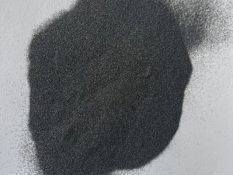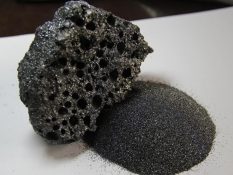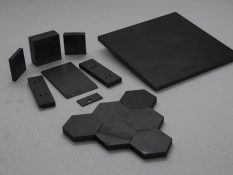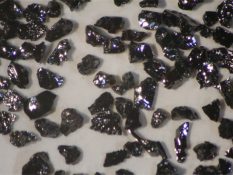News
As wear-resistant and high-hardness structural ceramic materials, boron carbide ceramics are important in new ceramics. Due to boron and carbon are non-metallic elements, the atomic radius of them is similar, and the way atoms bind is different from the general interstitial compounds, which make boron carbide ceramics possessed with high melting point, ultra-high hardness, low density, wear resistance and corrosion resistance and many other unique excellent properties.
Boron carbide ceramics are increasingly showing the broad development and application prospects in the fields of national defense, nuclear energy, aerospace, machinery, wear resistance technology, etc.
1 The properties of Boron carbide ceramic
Boron carbide was first discovered in 1858, but it was not until 1934 that a stoichiometric compound with the formula B4C was proposed and recognized.
Boron carbide is a superhard material with a hardness second only to diamond and cubic boron nitride among currently known materials. With a hardness of up to 3000kg/mm² and 2.52g/cm³ low density, one-third times of steel. Boron carbide is featured with high modulus of elasticity to be 450GPa and high melting point about 2447 °C. The low CTE results in a high thermal conductivity of boron carbide.
In addition, boron carbide has good chemical stability, acid & alkali resistance and corrosion resistance. Apart form acid and alkali, boron carbide also does not react with most inorganic compound liquids at ordinary temperature. Boron carbide has slow corrosion in hydrofluoric acid-sulfuric acid, hydrofluoric acid-nitric acid mixture, and does not wetten or react with most molten metals. Boron carbide absorbs neutrons well, which is the ability that other ceramic materials do not possess.
The densification sintering of pure boron carbide is extremely difficult. This is because the number of covalent bond copies reaches 93.94%, which is higher than other structural ceramics, such as SiC (88%), Si3N4 (70%), etc. Therefore, only at high temperatures above 2000 °C can boron carbide realize the elimination mechanism of internal pores and the mass transfer mechanism of grain boundary and volume diffusion.
For example, ordinary B4C powder is sintered at atmospheric pressure at 2250~2300 °C, and can only reach 80%~87% relative density. Sintered at such a high temperature, the grains will be rapidly coarsed and grown, which is not conducive to the elimination of pores, therefore cause a large number of residual pores to limit the density of the material. Thus, the sintering of boron carbide must be carried out with effective additives or through pressure sintering.
2 Application of boron carbide ceramics
As mentioned above, B4C ceramics have low density (lower density than SiC and Si3N4 ceramics), high hardness (higher than SiC and Si3N4), high modulus of elasticity, corrosion resistance, wear resistance, good neutron absorption performance, and good high-temperature semiconductor characteristics, which to make them widely used in the fields of national defense, nuclear energy and wear-resistant technology.
3.1 Field of bulletproof armor
Due to the features of lightweight, ultra-hardness and highly modulus of elasticity, B4C ceramics are the optimum materials for bulletproof vests, bulletproof helmets and bulletproof armor.
Boron carbide ceramics have been used as ceramic armor materials since 1960s. Compared with other bulletproof materials (such as SiC, Al2O3), B4C ceramics are lighter and harder, particularly suitable for use in armed helicopters and other aircraft as bulletproof armor materials, which can effectively resist artillery shells. Therefore, generally B4C ceramics are only used in certain special occasions with high requirements for protective performance, such as the crew seat of the US military's V22 "Osprey" rotary-wing aircraft. In addition, the Enhanced Human Armor (EBA) used by the British Army also uses boron carbide ceramics, which can protect against 12.7mm steel core armor-piercing bullets.
Boron carbide ceramics produced by the advanced ceramics branch of BAE Systems in the United Kingdom have been used as body armor of the US military "interceptor". In 1997, the U.S. Army settled a research project on ceramic armor processes in its Manufacturing Technology Program, which focused on the low-cost mass production of boron carbide (B4C) light arms protective insert armor for the Interceptor body armor system. Participating units include the U.S. Marine Corps, U.S. Army Soldier and Biochemical Command, Specialty Defense Systems, Simula Isoyama, Cercom, and CoorsTek and Ceradyne. By 2012, 68,000 Interceptor body armor were on the battlefield.
3.2 Wear-resistant technology field
In the field of wear-resistant technology and engineering, various nozzles are prepared by utilizing the high hardness of B4C, including desanding nozzles for hull rust removal and nozzles for high-pressure jet water cutting. B4C nozzle has the longest life under harsh use conditions, dozens of times longer than the life of Al2O3 nozzle, much longer than SiC and WC nozzles, extremely cost-effective, all these advantages make it to be the best choice for the sandblasting industry.
The excellent chemical stability of B4C allows it to be used in the nozzles of slurries and liquid grinders; Mortars, rods and similar grinding devices made of B4C are the first choice in chemical analysis for their ability to avoid abrasion contamination during grinding.
In the processing of hard materials such as cemented carbide, engineering ceramics polishing, finishing or crushing process of abrasive materials, the use of boron carbide instead of the original diamond abrasive can greatly reduce the cost of the grinding process. For example, boron carbide devices are used as journal bearings for pneumatic spool valves, hot extrusion dies, and cooling systems of atomic power plants, also used as corrosion-resistant and wear-resistant components in ceramic gas turbines.
3.3 Nuclear energy field
In the reactor core assembly, neutron absorbing materials (control rod, regulating rod, accident rod, safety bar, shielding rod) are important functional elements after the fuel element. Due to the high neutron absorption cross-section, wide absorption energy spectrum, low price, rich source of raw materials, and no strong radiation of rays after neutron absorption, it is easy to dispose of waste. Therefore, boron carbide is a vital neutron absorbing material.
3.4 Thermocouple
Based on the thermoelectric properties of B4C, Japanese and German sintering prepared a thermocouple that can measure 2200 °C for high temperature measurement and control. Its high thermoelectrics and stability allow for long-term reliable use and repeated temperature measurements. A boron carbide/graphite thermocouple consists of a graphite tube, a boron carbide rod, and a boron nitride bushing in between. In inert gases and vacuum, the service temperature is up to 2200 °C. Between 600~2200 °C, it shows a good straight-line relation between the potential difference and temperature.
3.5 Other Applications
B4C is stable to molten iron and has good thermal conductivity, for which can be used as a continuous casting mold in the mechanical industry. Based on the resistance to strong acid corrosion and wear, B4C can be used for the flow transmitter shaft tip of rocket liquid engine fuel. B4C also acts as an excellent gas bearing material in long-life gyroscopes, which are extremely important sensors in inertial navigation and inertial guidance systems for aircraft, ships, space bridge vehicles and other vehicles.
4 Deficiencies of boron carbide ceramics
With the development of sintering technology, the excellence of boron carbide ceramics is becoming more and more prominent, and its products have special use value for the working environment such as high temperature, high speed and strong corrosive medium often encountered by modern process technology. In addition, there are many potential uses in various fields to be tapped.
Although boron carbide ceramics have been widely used, there are still some negatives restrict the large-scale application of boron carbide ceramic bulk materials, including high cost, low fracture toughness, high sintering temperature (about 2300 °C), poor oxidation resistance (oxidation at 600 °C in air, rapid oxidation at 900 °C), poor stability to metals (almost all metals except Ag, Cu, Sn, Zn, etc. to form metal borides), difficult machining, etc.
Therefore, it remains the necessity to regulate the structure and properties of B4C ceramics according to the requirements of the actual use environment for future development. On the other hand, New sintering technology should be continuously improved and developed, so as to improve its reliability and toughness, continuously reduce the manufacturing cost of B4C to make boron carbide ceramics——an excellent engineering material——more widely used.

Jun 09,2020
Grinding&Polishing Properties of Boron carbideBoron carbide is a highly valuable variety of…


Jul 17,2023
Use of Boron carbide as chemical additiveBoron carbide (B₄C) is an inorganic substance, also kno…

Jun 16,2023
Bullet proof performance of silicon carbide vs Boron carbide ceramicPeople are universally impressed with the view that cer…